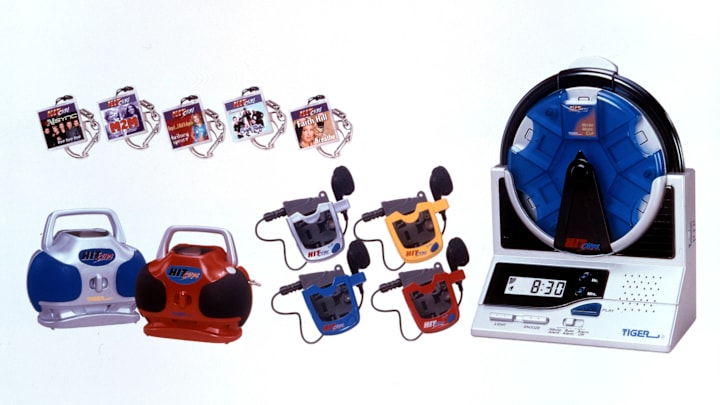In 2002, Mathew Knowles, father and manager of Beyoncé Knowles, took a moment to credit the success of his daughter’s latest album to a toy.
Survivor, recorded by Knowles and other members of Destiny’s Child, had sold 8 million copies—a number made possible in part by HitClips, a small electronic device marketed by Tiger Electronics. The tiny unit acted as a miniature boombox and accepted music software on a chip no larger than a postage stamp. Their lead single off the album, also titled “Survivor,” was a bestseller on the platform.
“We wanted to reach the younger market, between 6 and 10,” Knowles said. “You want to build a base because the younger fans stay.”
The music industry agreed with him. First introduced in 2000, HitClips were a strange amalgam that functioned as both a toy and as portable audio equipment. Though the crackling mono sound was hardly an audiophile’s dream, the novelty of it was a hit with kids.
But its success was confounding to some. Why? Users could hear only one minute of a song.
Record Sales
The idea of putting music in the pockets of consumers was hardly revolutionary. Cassette tapes, which debuted in the U.S. in 1964, helped shrink music libraries down. Then the Sony Walkman, released in 1979, made it easy to take music on the go—so much so that the company sold over 400 million of these portable players in the process. CDs and MP3s followed, with the Apple iPod ushering in a new wave of portable sound beginning in 2001.
These were, of course, consumer-grade electronic devices—you weren’t likely to find them in toy aisles. But Tiger Electronics, owned by toy giant Hasbro, believed there could be a successful marriage of music and the kind of collector’s mentality that made phenomena like Pokémon possible.
Inventors Dave Capper and Andy Filo pitched Tiger on the idea of a portable music player for kids 5 to 10 years old who might have become too sophisticated for dolls or squirt guns but who weren’t quite ready for an eardrum-busting CD player.
“They’re losing interest in Barbie dolls and other traditional toys,” Capper told The Globe and Mail in 2001. “But they do like music, and we thought we could combine that with the new chip technology.”
Rather than CDs, kids could buy tiny samples of music on tangible chips to play on a separate listening device. And it wouldn’t be Barry Manilow: HitClips featured the likes of NSYNC, Britney Spears, Mandy Moore, and other millennial-friendly pop stars. Thanks to the key ring on each of the tiny plastic squares, kids could clip them to backpacks, waists, keychains, or bracelets.
Initially, record companies were cool on the idea. If a kid could buy a portion of a song priced from $3.99 to $5.99, why not buy an entire album for $15? But HitClips actually amounted to a sample: Instead of cannibalizing sales, it boosted them. Kids were incentivized to try different kinds of music. If they liked “Bye, Bye, Bye” by NSYNC, perhaps they’d be tempted to grab the whole album. Helping the cause was an early deal struck with McDonald’s, which put HitClips inside of their restaurants, quickly building word-of-mouth.
As more and more artists flocked to HitClips, Tiger had to begin vetting. While most pop music was welcome, the brand had to be aware of their adolescent audience. A Black Sabbath HitClips was a no-go. “We’re careful not to choose songs that might contain innuendoes not suitable for children,” a Tiger spokesperson said. “There’s no rap or heavy metal.”
Pocket Music
Being small and subversive was also part of the appeal. Thanks to their size and the tiny earbud that snaked out from the quarter-sized player, kids could rock out to some Smash Mouth when science class grew boring. And if they tired of their song library, they could swap HitClips with friends.
“I think it’s really cute and different but it’s also easy to lose,” high school security guard Joyce Quinn told The Times-Herald Record in 2000. “The only thing that’s bad about it is that kids will be sneaking these into school and we’re trying to discourage them from bringing in radios, Walkmans, and cell phones. It could lead to a problem.”
It wasn’t a problem for Tiger, which sold a staggering 12 million HitClips by 2002. Nor was the one-minute limit a technological limitation. The chips could hold more music, but it would have been too expensive for the kid set.
Tiger also provided an assortment of playback devices, from the ultra-slim Personal Player ($7.99) and the Rockin’ Micro Boombox ($9.99) to the HitClips Alarm Clock ($14.99) and a Karaoke Machine ($9.99) that came with a tiny microphone. A HitClips Downloader ($24.99) allowed web-savvy users to download sound snippets to blank chips.
Tiger also had spokespeople, including Hilary Duff and Raven-Symoné. In 2004, Tiger introduced circular HitClips to better resemble compact discs. But the trend was fading. Despite 30 million units sold, the HitClips fad wound down by 2004, as downloads—both legal and otherwise—became too convenient to ignore.
Capper and Filo, the co-inventors of the device, later debuted Tooth Tunes in 2006; the electric toothbrush played pop songs only when the brush was pressed against teeth. This time, the songs lasted a full two minutes—the time for brushing most recommended by dentists.
